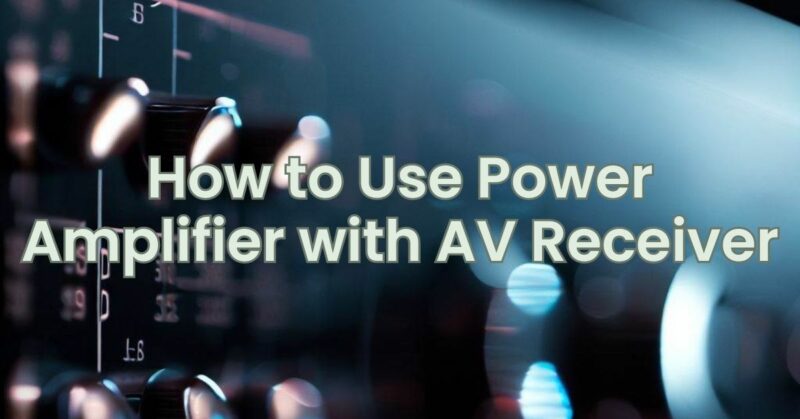Combining the power and finesse of a dedicated power amplifier with the versatility of an AV receiver can take your audio system to new heights. By incorporating a power amplifier into your setup, you can enhance the performance and dynamics of your speakers while leveraging the processing capabilities of an AV receiver. In this article, we will guide you through the process of using a power amplifier with an AV receiver, unlocking the full potential of your audio system and delivering a captivating listening experience.
Step-by-Step Guide:
Before you begin, ensure you have the necessary cables and equipment ready:
- Assess Your AV Receiver: Determine whether your AV receiver has preamp outputs or pre-out jacks. These are typically labeled as “Pre-Out,” “Front Out,” or “Zone Out.” These outputs provide a line-level signal that will be connected to the power amplifier.
- Identify Power Amplifier Inputs: Locate the line-level inputs on your power amplifier. These inputs are usually labeled as “Line In” or “Input.” You will connect the preamp outputs from your AV receiver to these inputs.
- Prepare the Cables: Obtain high-quality RCA cables or XLR cables, depending on the input and output connections of your AV receiver and power amplifier. Ensure you have the appropriate cables to establish a reliable connection.
- Connect the AV Receiver to the Power Amplifier: Take one end of the RCA or XLR cables and connect them to the preamp outputs on your AV receiver. Match the left channel output to the left input of the power amplifier and the right channel output to the right input of the power amplifier.
- Power On and Configure: Once the connections are established, power on your AV receiver and power amplifier. Configure your AV receiver to enable the preamp outputs. Refer to the user manual for your AV receiver to find specific instructions on how to activate the preamp outputs.
- Set Volume Levels: Ensure the volume levels on both your AV receiver and power amplifier are set to a comfortable starting point. It is generally recommended to keep the volume level on the AV receiver at a moderate level and use the power amplifier’s volume control to adjust the overall volume. This arrangement allows you to maximize the power and control offered by the power amplifier.
- Speaker Connection: Connect your speakers to the speaker outputs on the power amplifier. Ensure proper polarity (+/-) and secure connections to guarantee optimal sound quality.
- Testing and Fine-Tuning: Play audio through your AV receiver and power amplifier setup. Verify that sound is being produced through your speakers connected to the power amplifier. Fine-tune the volume levels and audio settings to achieve the desired sound quality, balance, and dynamic range.
Additional Considerations:
- Impedance Matching: Ensure that the impedance ratings of your speakers, AV receiver, and power amplifier are compatible. Matching the impedance levels helps prevent distortion and damage to your audio equipment. Refer to the user manuals or specifications of your devices for recommended impedance ranges.
- Power Amplifier Placement: Consider the placement of your power amplifier, as it may require proper ventilation due to increased power output. Ensure there is adequate space around the amplifier for proper airflow and cooling.
- Power Control and Trigger: Some AV receivers offer a power control or trigger output that can be used to automatically turn on/off the power amplifier when the AV receiver is powered on/off. Check if your AV receiver has this feature and consult the manuals for both the AV receiver and power amplifier to set it up correctly.
- Speaker Setup and Calibration: If your AV receiver has room calibration capabilities, such as Audyssey or similar systems, run the calibration process to optimize the sound quality and speaker performance within your listening environment. This calibration helps ensure accurate sound reproduction and integration between the AV receiver and power amplifier.
Conclusion:
Integrating a power amplifier with an AV receiver empowers you to elevate your audio system, delivering greater power, precision, and dynamics to your speakers. By following the step-by-step guide and considering additional factors, you can unlock the full potential of your speakers while leveraging the processing capabilities of your AV receiver. Experiment with different settings, configurations, and speaker placements to achieve the optimal sound quality and immersive listening experience you desire.


